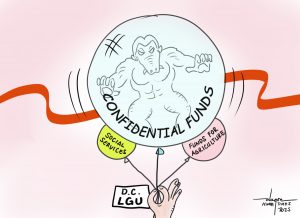 As of the weekend, the last news we heard about the development of the Samal Island-Davao City (SIDC) Connector bridge project was the borehole drilling activities being started on the Davao approach by the workers of the Chinese contractor.
As of the weekend, the last news we heard about the development of the Samal Island-Davao City (SIDC) Connector bridge project was the borehole drilling activities being started on the Davao approach by the workers of the Chinese contractor.
Based on the pronouncement of the spokesman of the Department of Public Works and Highways (DPWH) Dean Ortiz, who is now the designated source of official information on anything about the project, it appears that there is nothing that will stop the start of the construction – not even the outcry of those who believe that they are adversely affected economically, as well as those who have devoted a great deal of their lives protecting and preserving the environment.
From the looks of it, a court action – if resorted to – may only delay the start of the construction. Still, it is unlikely to stop the project, which many, if not all Davaoeños (Samalenos included), believe will positively impact the island city’s economy.
Even those who are the more vocal in their protestation – not necessarily against the project but on the location of the bridge’s Samal side approach – agree that the infrastructure will be a huge boost to the island’s maximum development. The latter sector and the environment guardians are apparently on their last possible option in their effort to convince the government to consider their suggested change in the bridge’s alignment, hoping that their resort businesses and the environmental cause could remain contributors to the advancement of Samal’s economy side by side with what the bridge will offer. The adversely affected business stakeholders are also hoping that consideration of their request for the change in the location of the Samal approach will sustain the livelihood of hundreds of individuals dependent on the continuity of operation of the affected resorts.
Anyhow, while we personally – and perhaps many others – are hoping for a win-win resolution of the conflicting issues, we remain a subscriber to the idea that the real measure of development is when a project results in a much bigger number of beneficiaries than those who stand to suffer from it. But determining the number of sufferers should not only be limited to the sphere of the area or places directly impacted by the project, like the Samal-Davao City Bridge. It should also include those outside but indirectly dragged to suffer from the consequences and the length of time they are likely to continue suffering.
If only to clarify our treatise and to give the people the opportunity to get an idea of the number of beneficiaries of the project and those of the prospective sufferers either by direct impact or by implication, we are carrying in full an article written by one Tom Villarin whose name sounds familiar to us. Still, we have not met even once. We have yet to find out if this write-up has already been printed in any of Davao’s local papers.
But we love the article in the way it is written and its relevance at this time when the controversy on the bridge project implementation still hounds and needs an acceptable resolution despite indications that it is now a “go”. Through the one who shared this with us, we sought Mr. Villarin’s permission to use his article as a major component in our today’s column. Through the persuasive approach of our friend-sharer we were told that we have Mr. Villarin’s approval.
Tom Villarin’s article is captioned “Tale of two bridges.” We have deleted a few words to avoid the possibility that we are politicizing the issue. Here is Mr. Villarin’s article:
“Two bridges in Mindanao being constructed by the national government would become the longest in the Philippines, surpassing the San Juanico Bridge that connects Samar and Leyte. These are the Panguil Bay Bridge connecting two regions – Zamboanga and Northern Mindanao, and the Samal Island-Davao City (SIDC) Connector Bridge, connecting, well just Samal and Davao City.
“But these two bridges stand as contrasting legacies of previous national government administrations – Aquino III and Duterte. The Panguil Bridge was signed during PNoy’s term through a Build-Operate-Transfer/Public-Private Partnership scheme that cost less, while the SIDC was during his (Aquino III) successor President Duterte through a loan from China. While having almost the same lengths, the two have different price tags – P7.3-B for Panguil and P23-B (not including interest, most likely) for SIDC. Of course, the Panguil Bridge is only a 2-lane bridge, while the Samal-Davao Bridge is a four-lane bridge. Why a four-lane bridge to connect to Samal is mind-boggling. Also, part of the loan agreement stipulates that a Chinese company would be given the project.
“The SIDC had been planned since 2002 but only took off under the Duterte administration. Originally planned to connect Panabo City to Babak, Samal, both being under the Province of Davao del Norte, it is now to be constructed right smack in Samal’s famed Paradise Island Resort, as well as in major dive spots where coral reefs abound. Thus, this has created a major uproar among environmental groups and concerned citizens.
“If SIDC was intended to promote Samal as a tourism site with its famed white sand beach resorts and dive spots, then building a bridge that destroys these tourism spots kills the goose that lays the golden eggs. It also bloats the budget for right-of-way acquisition as the alignment approaches hit already built-up areas with high zonal valuations. The Davao approach likewise can cause heavy traffic since it drops on the city’s flood-prone area.
“Was there a comprehensive environmental impact assessment made? Were environmentalists, academe, business groups, divers, etc. consulted? Was the rest of the country asked about this project, as we all have to pay for the loan to China? How would the P23-B cost of the project be recovered, and for how long? The project is estimated to be finished in five years, but it could extend. In the meantime, the natural environment (corals and Nemos) will be degraded, livelihoods lost, and traffic jams in Sasa, a major avenue for cargoes and people, will further be aggravated.
“On the other hand, the Panguil bay Bridge is more than 50 percent complete and would be operational in 2023. Its economic impact would be tremendous as it lessens land travel between Zamboanga and Cagayan de Oro by two hours. It would also open up shipping routes (Panguil Bay to Cebu City) where an international port can be built in say, Jimenez, Misamis Occidental, where a natural harbor exists. Most likely, goods from as far as Central Mindanao/Maguindanao and Bukidnon will find their way crossing Panguil Bay Bridge to be shipped to Visayas, Luzon, and abroad. Davao’s port, meantime, will just handle bananas and crops from the neighboring Caraga Region. And bringing goods from Davao to Manila won’t be cheap as it is hundreds of nautical miles away than if it is shipped from Panguil Bay.
“So, Mindanaoans and Filipinos, which of the two bridges have a lasting, environmentally sound, and economically feasible project study? Who benefits, and are the costs evenly spread?
“I think the SIDC project has to be re-evaluated and national consultations be made about its impact. All Filipinos will, in the end, pay for this project. Not just the Davaoenos.”
Indeed, this Tom Villarin’s article is not just worth reading; it’s one good food for thought for all those who find the bridge a project for future generations who stand to either benefit or suffer from whatever its consequence will be.


